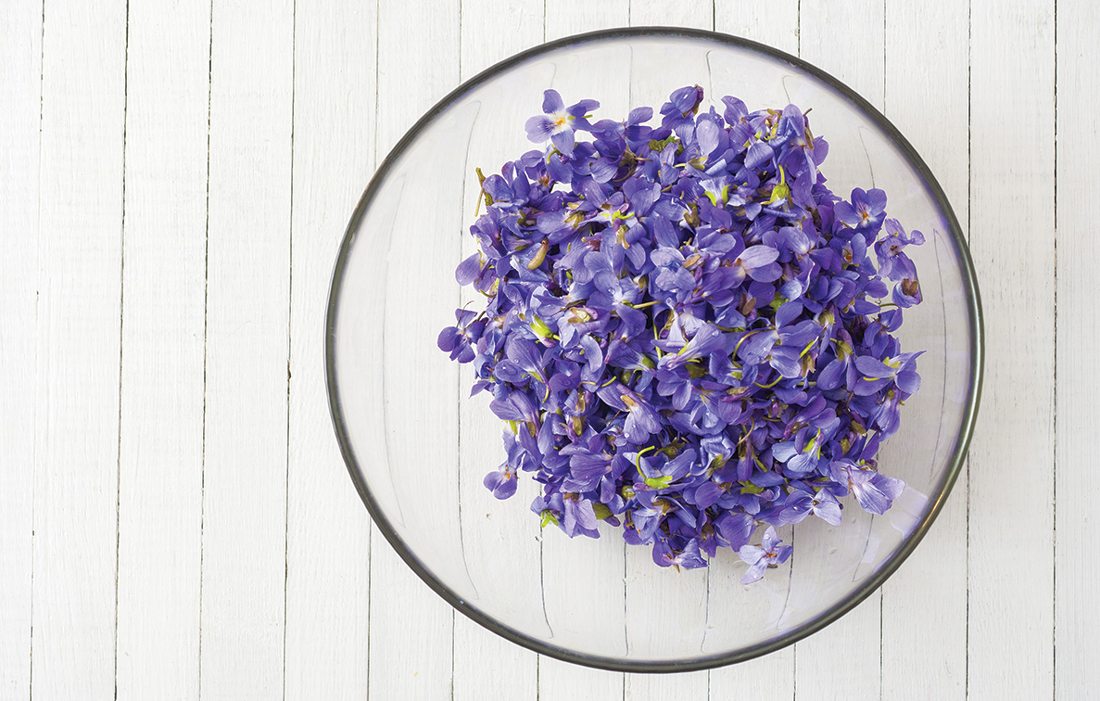Violet Simple Syrup Recipe
Bring fresh and colorful ingredients into your kitchen by foraging for spring’s most edible wildflower, the violet.

Written by Heather Kane Kohler
It’s impossible to ignore the Missouri wild violets sneaking into the cracks of your sidewalks, yard and garden edges this spring. This vibrant flower, whether in small bunches or in sweeping clusters, brings a beautiful display of violet color, but their beauty isn’t the only useful thing weed-like flowers bring to the season. These tiny little gems can be recognized by their rich color and unique flower with two petals pointing up and three pointing down. Most violets do not have a true stem—the leaves grow directly from the ground, just like dandelions. Along with adding to spring’s emerging color palette, wild violets play an important role with pollinators, acting as a host to a specific species of butterflies called fritillaries, known for their chessboard pattern and likeness to monarchs. The larvae of these butterflies need to feed on spring violets to survive the season.
Violets have been used for hundreds of years, medicinally and as food. Most violets are edible, including the white, purple, blue and multicolored varieties. Yellow violets are harder to find in the area and may not be as tasty as their purple and blue counterparts. One should note that African violets are not edible and are part of a different plant family. Violets are among the most fragrant wild flowers found in the Ozarks, making them excellent sources for teas and perfumes.
When foraging for wild violets, you should know the area well enough to know if it’s been treated with chemicals, and of course always leave enough flowers for wildlife and pollinators. Picking violets after a spring rain can be a wonderful experience, and the flowers are usually very happy after a good rain. The petals are delicate, so be careful when plucking them from the grass. The calyx of a violet is the cup-like base of the flower that’s made up of five green sepals. You want to pick beneath that. The whole flower (including the calyx) can be used to toss into spring salads, or you can make sugared violets to add to cakes. Author and expert forager Rachel West adds them to quiche and freshly baked cookies, by simply adding them toward the end of their baking time.
One of the most popular ways to enjoy the sweet floral flavor of wild violets throughout the season and beyond is making violet syrup. Local conservationist Siw Shauni Hauger loves foraging for violets each spring and making her own syrups. “The most important part of making violet syrup is to remove all green bits, as they will make the flavor grassy rather than fruity floral,” says Hauger. “So the whole calyx has to be removed.” Hauger uses her syrups to make cake glazes and beautifully colored frosting. “It’s also great in cocktails or mocktails,” she says.
Ingredients
1 cup of violet petals, gently packed, stems and calyxes removed
1 cup of water
1 cup of sugar
In a glass bowl, add your petals and pour one cup of boiling distilled water over them. Stir well with a wooden spoon. Pour one cup of sugar into the bowl and gently stir the sugar until it dissolves completely. Place it on a hot pad to cool. Strain the violet-infused water into a clean jar using a fine-mesh strainer. This beautiful syrup will keep refrigerated for six months.








